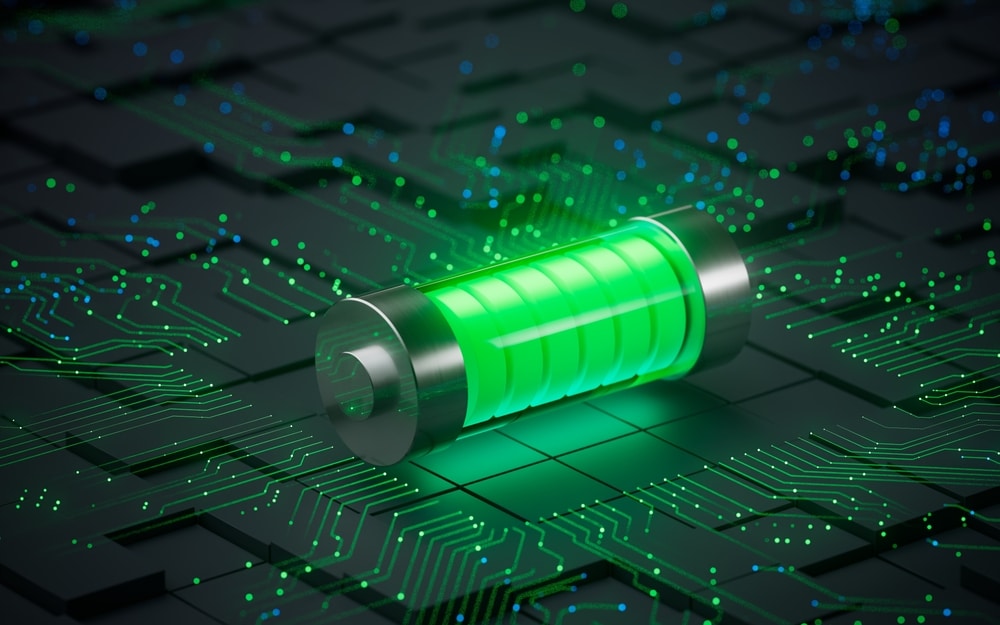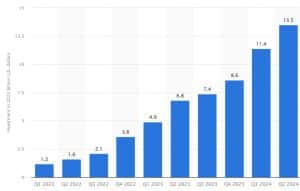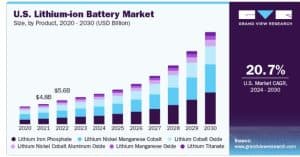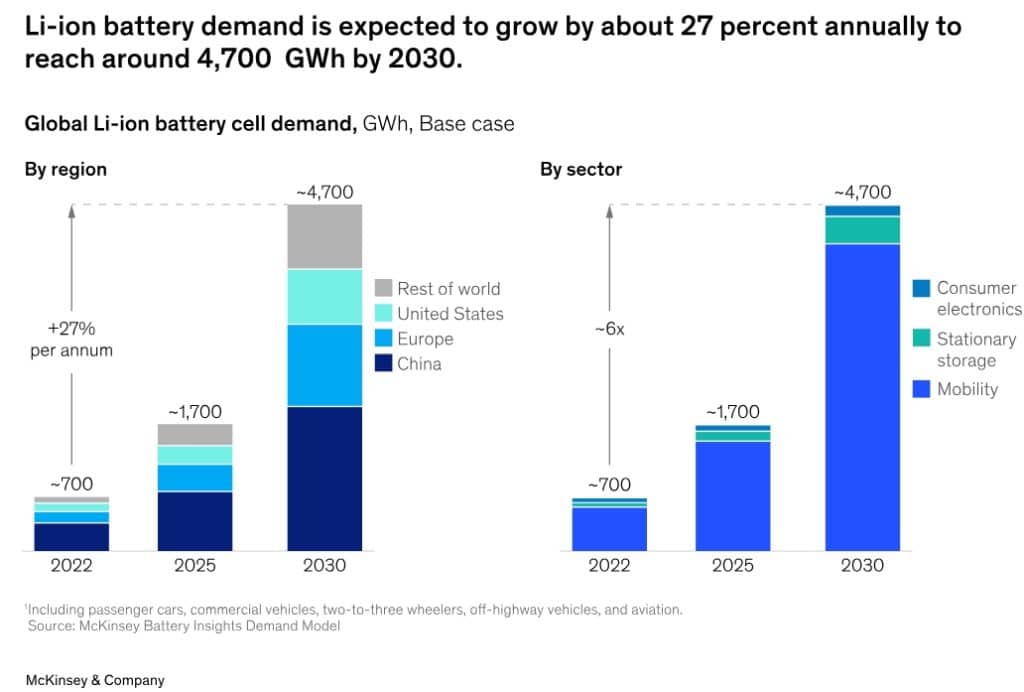On September 20, the U.S. Department of Energy (DOE) announced over $3 billion in funding for 25 projects across 14 states. These initiatives are a part of the Biden-Harris Administration’s Investing in America agenda, which aims to boost domestic production of advanced batteries and essential materials like lithium.
Unlocking DOE’s $3B Boost for a Stronger U.S. Battery Industry
Notably, this effort builds on the administration’s previous commitment of nearly $35 billion to strengthen U.S. critical minerals and battery supply chains. The $3 billion in grants for these new projects will help expand EV and energy storage production while reducing reliance on foreign supply chains, particularly China’s.
Furthermore, the selected projects will be administered by the U.S. DOE’s Office of Manufacturing and Energy Supply Chains (MESC). The main goals of the funding are:
- Build a robust domestic battery supply chain, including the production of key battery components like cathodes, anodes, and electrolyte materials. These elements are crucial for both current and next-generation battery technologies.
- Focus on constructing, expanding, and retrofitting facilities for battery production, recycling, and the processing of critical minerals, such as lithium, graphite, and manganese.
U.S. Secretary of Energy Jennifer Granholm emphasized the importance of this initiative, stating,
“We’re witnessing a manufacturing revival in America, thanks to the Investing in America agenda. By establishing the U.S. as a leader in battery manufacturing, we’re not only creating high-paying jobs but also securing our energy future and strengthening our global leadership.”
Battery manufacturing investment in the United States from 1st quarter 2022 to 2nd quarter 2024
Source: Statista
- READ MORE: The Clean Energy Powerhouses: US Lithium Imports Soar 49% and Argentina’s Copper Ambitions
Key Projects in Lithium Extraction and Recycling
Arkansas and Texas
Among the new projects, the DOE awarded the two largest grants—$225 million each—for direct lithium extraction (DLE) initiatives. These projects will be based in Arkansas and Texas, both part of the Smackover Formation. SWA Lithium LLC, a joint venture of Standard Lithium Ltd. and Norway’s Equinor ASA, is one of the recipients. Their Arkansas-based project aims to produce 45,000 metric tons of battery-grade lithium carbonate per year.
The DOE also selected Terravolta Resources LLC for another $225 million grant for a DLE project located in the Texarkana region. This project will focus on producing 25,000 metric tons of lithium carbonate annually.
Another significant investment includes a $200 million grant to Cirba Solutions US Inc., which plans to build a lithium-ion battery recycling facility in Columbia, SC. The plant will recycle batteries from EVs, energy storage systems, and consumer electronics, processing up to 60,000 metric tons per year.
South Carolina and Michigan
The Cirba Solutions project is one of five selected facilities in South Carolina. It is joined by a $198.7 million grant awarded to EnerSys Advanced Systems Inc. to establish a new lithium-ion battery cell plant in Piedmont, SC, set to begin production in 2028 with an initial capacity of 5 GWh.
In Michigan, four projects were highlighted, including a $145 million grant for Revex Technologies Inc. to collaborate with Eagle Mine LLC, a subsidiary of Canada’s Lundin Mining Corp., on the REV Nickel Project. This initiative aims to process Eagle Mine waste and spent batteries to recover valuable materials.
Additionally, Mitra Future Technologies Inc. received a $100 million federal grant for a facility in Muskegon, focused on producing lithium iron phosphate cathode materials for electric vehicles, energy storage, and defense applications.
On the West Coast
The DOE also selected Group14 Technologies Inc. to negotiate a $200 million award for a silane production facility in Moses Lake, Washington. This facility will manufacture silicon-based anode materials. Furthermore, Form Energy Inc. received a $150 million grant to support its production of iron-air battery storage systems at a factory in Weirton, West Virginia.
Meanwhile, Reuters reported Albemarle is slated to receive $67 million for a project in North Carolina aimed at producing commercial quantities of anode material for next-generation lithium-ion batteries. Additionally, Honeywell will be awarded $126.6 million to build a commercial-scale facility in Louisiana that will produce a key electrolyte salt essential for lithium batteries.
The media agency also noted that DOE intends to grant DOW Chemical Company $100 million to manufacture battery-grade carbonate solvents for lithium-ion battery electrolytes. Others in the pipeline include Clarios Circular Solutions, in partnership with SK ON and Cosmo Chemical will receive $150 million for a project in South Carolina to recycle lithium-ion battery production scrap materials from SK ON, the battery division of SK Innovation.
A Bold Step Toward Economic and Energy Security
John Podesta, Senior Advisor to President Biden for International Climate Policy, remarked on the importance of securing EV and battery supply chains.
“The administration is using every tool available to onshore and ‘friend-shore’ supply chains. This will boost national security, strengthen our economy, and help combat the climate crisis,”
The press release mentions, the battery sector will see a total investment of $16 billion, which includes contributions from private companies. However, a significant purpose of the selected projects is job creation. Considering this, more than half of the 25 projects have committed to labor agreements and can potentially create 8,000 construction jobs and over 4,000 long-term operating jobs.
The next step for these projects involves a negotiation process with the DOE before funding is finalized. Environmental reviews will also be completed during this time. This groundbreaking investment boosts domestic battery manufacturing and strengthens the country’s leadership in the global clean energy transition.
Shifting Dynamics in the U.S. Battery Market
Batteries are crucial to enhancing the U.S. energy grid, powering homes and businesses, and supporting EVs. It’s a known fact that China has dominated the battery market, controlling key minerals like lithium, and rare earth elements. However, U.S. production is rising.
The U.S. is intensifying efforts to boost domestic battery manufacturing by implementing robust measures to protect its interests. Furthermore, the Biden administration is introducing new tariffs on Chinese products, including lithium-ion batteries and EVs.
This effort not only propels the US battery industry forward but also drives innovation and minimizes dependence on foreign suppliers. All in all, it would position the country as a leader in clean energy, ensuring access to crucial materials, mainly lithium remains domestic.





